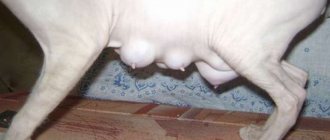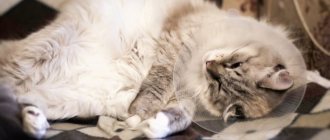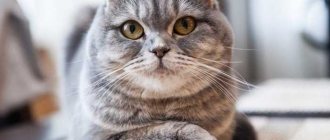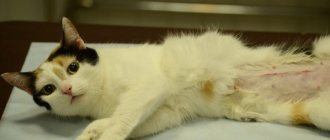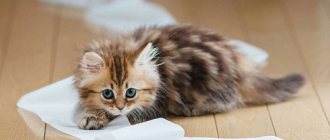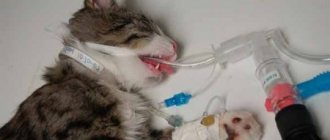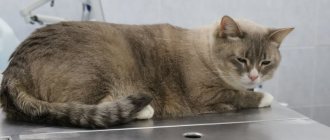Is anesthesia harmful?
There are many myths surrounding veterinary anesthesia. This is due to the fact that until the mid-90s, heavy drugs equated to narcotic drugs were used for operations. After a dose of such anesthesia, the animal could not always recover from anesthesia correctly. At that time, the percentage of cases where complications occurred was quite high - one in ten.
Today, veterinary medicine has stepped forward, and safer drugs are used for operations. A gentle effect on the body allows you to quickly remove the cat from anesthesia without harming it with aggressive “chemistry”.
The owner should take into account that the new drugs are more expensive than those used before. Therefore, if you are offered two types of anesthesia before the operation, do not skimp on your pet’s health and choose the more expensive one. The cat will be able to recover from such anesthesia faster and easier.
Behavior Change: Aggression and Marking
shutterstock
Changes in character are especially noticeable in aggressive pets, because after castration aggression disappears
There is an opinion that after castration the animal becomes lethargic and lazy, but this is not so, if you do not make it obese and pay attention, then this will not happen
It should be noted that castrated animals are better trained, because they become more focused.
Neutered pets are less likely to want to go outside, and this reduces the chance that the pet will get hit by a car, get poisoned, or be harmed by stray animals. A neutered pet will also communicate with other cats; the operation will not make him an outcast. At the same time, he will begin to treat other animals calmly, without aggression, which makes it possible to have another pet.
If he walks and reproduces, he will thereby increase the number of stray animals on the streets. For cats, mating is simply a method of continuing their biological species, and without experiencing sexual desire, they live without suffering. It will be much worse for your pet if you don’t let him go for a walk or give him pills.
- Getting rid of meowing during the mating season;
- Character improves, activity manifests itself;
- The likelihood of diseases occurring is reduced;
- The likelihood of an accident with a pet while walking is reduced;
- Aggression towards other animals disappears;
- Easier to train;
- Stops marking territory.
Almost all cat owners whose pets have undergone removal of the testes note how much the character of their pets has improved. Of course, if the cat was affectionate and gentle before the operation, he will remain so after it. But aggressive specimens, on the contrary, become much calmer, balanced and flexible. If previously communication with the owner was limited only to bites and scratches, then after castration such a cat can be petted almost without fear.
Castration does not affect the character of a young animal operated on at an early age. The cat will remain as playful and cheerful as it was before the operation, and, what is especially pleasant, will retain this character trait until old age. All that is required from the owners is to take part in his endless games and pranks or get him a companion - not necessarily a cat!
The situation is different with animals that were castrated at a fairly mature age, whose character has had time to fully develop. After castration, they become too phlegmatic for active games, preferring to spend time in a blissful slumber, basking in the sun or curling up in a secluded corner.
Such cats, whose body does not receive enough physical activity, may develop problems with the heart and joints, especially if they are overweight. This especially often affects cats of the British breed, whose phlegmatic nature has become the talk of the town. To maintain the health of your pet, try at every opportunity to stir him up and involve him in a fun game. And when the weather permits, put a harness on him and go for a walk. It will benefit both him and you!
Possible risk
Regardless of what drug is used, the animal’s respiratory cardiovascular system is still stressed. The task of the anesthesiologist and surgeon is to minimize unpleasant consequences after surgery, so you should only contact reliable and trusted specialists.
The veterinarian must examine the animal and select the optimal drugs for anesthesia. Problems and complications after surgery most often occur as a result of using inappropriate anesthesia for a particular animal.
Preparation
Preparation for surgery includes two stages: examining the patient and preparing everything necessary.
Survey
Before the operation itself, the cat must be examined by a veterinarian. During the examination, pulse, blood pressure and body temperature are checked. The doctor also feels the cat’s stomach and checks the oral cavity.
Blood and urine tests are collected. A blood test for biochemistry is necessary in order to detect hidden diseases that tend to manifest themselves after the body is exposed to anesthesia.
Ultrasound examination for internal pathologies is also practiced. This measure will help prevent your pet from being placed on the surgical table again.
Elderly animals are also recommended to undergo cardiac ECHO.
Preparation
If you have a planned operation, such as sterilization, rather than an urgent one, it is advisable to plan it in the morning. The owner must also arrange his schedule so that during the entire time the cat is recovering from anesthesia, there is an opportunity to care for it.
The cat is on a fasting diet before surgery, so do not feed your cat 12 hours before the procedure. The water must be removed 10 hours before surgery.
If you do not arrange such an “unloading”, food in the stomach can cause nausea during surgery, which is unacceptable.
If the operation is performed in a clinic, ensure comfortable transportation. It is best if transportation takes place not in public transport, but in a car. It is also possible to perform surgery at home. To do this, veterinarians visit your home; however, this method has its drawbacks. In an unexpected situation, the doctor will not have all the necessary equipment. It is also difficult to ensure complete sterility at home.
If it is possible to take the cat to the hospital, perform the operation only there.
Prepare:
- Hard box. You can bring a cat to the clinic in a carrier, but you cannot put a cat in there under anesthesia;
- A blanket in which the box will be wrapped;
- Several diapers to put on the bottom;
- Oilcloth;
- Eye drops.
General information
As you know, castration in most cases refers to an operation to remove the testes of a cat. Of course, there are less traumatic options when the testicles are preserved, but still in 90% of cases they are cut out. The operation itself is extremely simple and rarely requires full anesthesia. But in recent years (mainly for humanitarian reasons), even in this case, general anesthesia is increasingly used. It is not surprising that after recovering from anesthesia, a cat may vomit. This phenomenon is not absolutely normal, but it also does not pose any particular danger.
Very often, vomiting in a cat after castration is a consequence of gross non-compliance with the basic rules of preparation for surgery:
- The animal must not be fed at least 12 hours before the procedure. Ideally, this period is immediately increased to 16 hours.
- Two to three hours before surgery, the cat must not be given water.
- It is strictly forbidden to perform castration in cases where the pet is sick with something (this also includes severe cases of helminthic infestations).
In addition, immediately after recovery from anesthesia, your pet should not be given water (at least three hours later), and there is no talk of food at all!
You should wait about 12 hours, and only then start feeding the hungry cat. And this must be done using liquid broths. It is believed that a pet can be returned to its normal diet only after a few days. This way, his body is guaranteed to recover from the effects of anesthesia.
If you immediately give meat in pieces on the 2-3rd day, you shouldn’t expect anything good. The animal’s digestive system is still “inhibited” at this time, and therefore not only vomiting, but also diarrhea may develop. And all because the food will be poorly digested and will begin to rot, resulting in intoxication.
Remember, at least on the first day you should not give your cat anything “heavy”! If you want to pamper your pet, give him some commercial food specially designed for feeding sick and weakened animals.
It should be taken into account that tracheal intubation is often required during anesthesia. If this operation was not performed carefully enough, the walls of the organ are injured. The cat develops a feeling of intense tickling and develops a “metallic”, “barking” cough, which causes the animal to vomit. What other reasons contribute to vomiting?
Other predisposing factors
It happens that some cats come to their senses surprisingly quickly after anesthesia and feel good about it.
This, of course, is wonderful, but only in such cases the pet can begin to lick itself, and it will pay special attention to the “gutted” scrotum. And in her cavity after the operation there will be powder or something similar
It often happens that a cat vomits violently precisely because he has drunk too much levomikol or something similar. And vomiting in this case is the least of all problems. If a pet begins to lick a post-operative wound, suppuration will almost certainly develop, and the animal may die from sepsis and other dangerous phenomena.
It is also possible that your cat was suffering from a severe helminthic infestation at the time of castration. Toxins released by parasites can enter into a “symbiosis” with drugs administered during anesthesia. But there are also more dangerous factors. So, vomiting may indicate intestinal volvulus. Again, this often happens in cases where “compassionate” owners fed the operated pet heavily before surgery or immediately after recovery from anesthesia.
How does the cat feel?
Some owners worry that the cat will feel pain during surgery. It's a delusion. A number of drugs are used for anesthesia, which are aimed not only at “euthanizing”, but also at weakening the muscle tone of the animal. It happens that a cat can come out of anesthesia earlier than expected, sometimes on the operating table. Even in this case, the animal will not feel anything, thanks to drugs that “turn off” sensitivity.
Duration of anesthesia
The amount of time a cat spends “sleeping” largely depends on the type of substance administered, as well as the method of application. Simple surgical procedures, such as castration or dental surgery, are performed using short-term medications. After such anesthesia, the cat comes to its senses faster. Sometimes awakening happens while still in the clinic or on the way home.
Longer-acting drugs are used for complex operations. Anesthesia in this case lasts from two to 8 hours. The speed of recovery from “sleep” largely depends on the individual characteristics of the body.
After the operation, you need to ask your veterinarian how long the normal recovery from anesthesia lasts in a particular case.
Rehabilitation of a cat after sterilization by day
Please note that in cases where the operation was more or less successful, that is, as usual, you will only have to care for the cat for the first few days. Afterwards you just need to keep an eye on your pet.
First day
The most responsible and important period. There is no need to do anything special at this time, but:
About two to three hours after the cat comes out of anesthesia, the cat needs water. It should be given from a syringe, no more than 10 ml at a time. When an animal drinks, the owner must monitor whether it swallows the liquid. If necessary, you can help your pet by lightly massaging her throat. After 10-12 hours, it is advisable to place a bowl of water near the place where the cat is recovering from anesthesia.
The pet must be placed in a separate room, isolated from small children and pets.
It is imperative to monitor the cat’s body temperature and monitor the condition of the seam. If by the end of the first day it swells greatly, turns red, and the surrounding tissues become hot, you should immediately contact a veterinarian.
You need to carefully (!) monitor whether the cat is peeing. If there is no urination in the first 20-24 hours, call your veterinarian immediately. To prevent the animal from overexerting itself, you need to place a litter tray close to it.
It is advisable to immediately put a surgical blanket on the cat.
As a rule, the recovery period at this time does not require anything else. If the surgery is successful, the cat will usually sleep for the first time.
Second day
On the second day, the animal’s condition somewhat normalizes. The procedure is as follows:
Since the cat may be very weak, it is necessary to leave a bowl of drinking water near the place where she sleeps.
You can begin active feeding (not too zealous, however). A rich chicken broth is ideal. Denser foods should not be used.
At least twice a day, it is necessary to monitor the condition of the postoperative suture.
At least once a day, the surgical blanket should be replaced with a clean one.
If the cat begins to move around, be sure to remove chairs, bedside tables and other furnishings from the room. If an animal climbs onto them, it may fall from there.
Third and fifth days
During this period, the cat’s condition (especially after laparoscopic sterilization) almost returns to normal. Little is required from the owner:
- The pet continues to be fed with a saturated broth in which meat and vegetable baby food is diluted.
- It is mandatory to check the seam line at least twice a day.
Starting from the third day, the cat should experience calls to defecate. If they are not present (especially on the fourth day), consultation with a veterinarian is required.
The blanket continues to be changed as it gets dirty, but at least once a day.
Sixth and seventh days
This time (in most cases) is characterized by almost complete restoration of all body functions. So the rehabilitation of a cat after sterilization usually proceeds as usual; little is required from the owner:
Providing high-quality food, balanced in micro- and macroelements, vitamins (i.e., from the sixth day the cat can be switched to regular food).
The blanket, as a rule, has already been removed, but monitoring of the condition of the seam is still continued.
There is no need to allow the animal to play too actively; it is better not to let the cat outside at this time.
Second week
The sutures are usually removed approximately 10-14 days after sterilization. No further special care for the cat is required. The rehabilitation period is almost over by this time. True, the body of the “old people” requires a little more, but they also feel good in the second week.
Anesthesia and eyes
The cat's body is designed in such a way that while under anesthesia, cats' eyes remain open. This does not mean that the animal can see everything around during the operation.
To prevent the mucous membrane of the eye from drying out, the veterinarian will advise you to buy special eye drops. Not vitamin solutions and medications that relieve redness, but ordinary drops that prevent the cornea from drying out. They need to be dripped into the cat during surgery, as well as periodically during recovery from anesthesia.
When instilling, you need to press the upper and lower eyelids, simulating blinking, because the cat's eye itself will not be able to distribute the solution throughout the mucous membrane.
Description of sterilization and its types
This operation is done to limit the functioning of the genital organs responsible for reproduction or to completely remove them. There are many ways to sterilize an animal:
- In an ovariohysterectomy, the ovaries are removed through an incision in the abdomen or side.
- During laparoscopy, organs for reproduction and bearing offspring are cut out through small punctures in the abdomen.
- In an oophorectomy, the ovaries are removed through an incision in the abdomen. In this case, the uterus is not affected and turns into a useless organ.
- Using a chemical (radiation) method, the animal is irradiated. The functions of the ovaries are impaired.
- During medical sterilization, sexual functions are suppressed through medications.
- With tubal occlusion, the reproductive organs are not removed, only tubal ligation is done. At the same time, sexual desire and cycle are preserved.
The operation is performed under general anesthesia. The duration of the procedure is 20-40 minutes. The sutures heal within a week, and the rehabilitation period can last up to 14 days.
First hours
After the administration of anesthesia, the first day is considered critical. At this time, it is necessary to constantly be near the animal and observe its condition.
After coming home, the cat should be placed in a soft and warm place. Make sure that your pet is not exposed to drafts, and also isolate the “bed” from other animals in the house. Keep children away from the cat's resting place.
You can't put a cat on a hill. When he wakes up from anesthesia, he will not have full control of his movements and may fall. Therefore, the bed needs to be arranged on the floor. Place an oilcloth under the bed, as the cat will not be able to control its needs at first. And periodically you will need to clean up after it.
The cat should be laid down so that the stitches after the operation are in the most relaxed position. The cat should not pull or rub anything.
After abdominal surgery, your cat will need to wear a blanket. This will protect the stitches from contamination and keep them safe when the animal wakes up and tries to examine the scar.
What to feed a sterilized cat
Immediately after surgery, the animal experiences psychological and physiological stress. Therefore, if a cat does not eat for 24 hours after sterilization, this is absolutely normal. Usually her appetite returns gradually. Everything is much worse when the cat does not drink for 7-8 hours after sterilization. She gradually begins to become increasingly dehydrated. If the animal still does not drink the next day, you should immediately contact the clinic. It is possible that the operation was not without complications, and therefore urgent medical intervention is required. For a weakened animal, the doctor will prescribe IVs and subcutaneous infusions that will combat dehydration.
When can you feed a cat after sterilization? Veterinarians recommend maintaining a fasting period for at least the first 12-16 hours after surgery.
In cases where the animal requires a large amount of food, it should still be limited in the first few days. This will help avoid unnecessary stress on the digestive organs.
The cat's diet after sterilization during the first week should consist of foods that will not cause problems with bowel movements. After them, she should easily go to the toilet. Unnecessary stress on the stitches due to constipation or diarrhea can significantly increase the healing process. So, for example, you could use the following:
- Natural yogurt, low-fat yogurt or 10% cream.
- Beef broth without fat and salt.
- Raw or boiled egg.
- Special canned food for animals after surgery.
In the first 3-4 days, meat and cereals should be completely excluded from the cat’s diet. If necessary, they can be replaced with baby meat puree with the addition of vegetables. Water should be given to the cat in unlimited quantities during this period. If your pet doesn’t drink much, you don’t need to force it to drink; perhaps it gets most of its liquid from liquid food.
Making up a diet
In animals undergoing surgery, the metabolic rate decreases and appetite increases. As a result, with an unbalanced diet, they develop obesity. Therefore, after you have sterilized your cat, you cannot return to normal nutrition. If you don’t have time to prepare natural food, you can use ready-made diets. Feeding a sterilized cat with industrial food is not as harmful as is commonly believed.
The main thing is not to use cheap economy class food. Its quality is very doubtful. In most cases, after consuming it, animals develop problems with digestion, liver and kidneys. It is advisable to purchase good premium cat food from veterinary pharmacies or specialized stores. This is the only way to completely eliminate fakes.
When creating a natural diet, preference should be given to lean beef or chicken breast. It is not recommended to feed pork and lamb. Feeding after surgery also has other features. For example, a sterilized cat should not be given fish, especially raw fish. It has a fairly high phosphorus content. In the urine, its salts can precipitate into an insoluble precipitate, which leads to the development of urolithiasis.
Also, when eating natural foods, you should definitely include a small amount of vegetables in your diet. For example, you can use cabbage, zucchini or pumpkin. It’s rare that a cat will eat them on its own. Therefore, puree is prepared from vegetables, which is mixed with minced meat.
Vitamins should also be present in the diet of a sterilized pet. For this, it is most convenient to use specialized vitamin complexes. To choose the most suitable one, it is best to contact a veterinarian.
Fermented milk products should be given several times a week. For example, low-fat cottage cheese or kefir. The lactic acid bacteria they contain will promote normal digestion.
Awakening
In most cases, the cat comes to its senses within 4-6 hours after arriving home. When the cat wakes up, it will immediately try to get up. It is important to ensure that the animal does not harm itself with sudden movements, since some pets immediately try to run away, not understanding the source of the discomfort.
If the cat tries to get up, offer him water. Avoid long “walks”; carefully place your pet back on the bed every time he tries to get up.
It is important to understand that the behavior of a cat during recovery from anesthesia is an unpleasant sight. The animal looks pitiful, it cannot control its body, and its legs constantly bend. This situation is normal, so you should not try to help your cat unnecessarily. It is better to provide her with peace and monitor her condition.
Some animals may show aggression, this is also normal. The cat does not understand what happened to him and tries to defend himself in the style of a predator - to attack an imaginary offender.
Try not to irritate your pet again. The room should be quiet and calm. Otherwise, the cat will try to hide from intrusive people.
The cat behaves aggressively: we are looking for the reason
In fact, by nature, domesticated felines are affectionate and playful. All you have to do is pet the fluffy sissy, and he will jump onto your lap and announce his good-natured attitude with a loud purr. What to do if the picture observed by the owners every day is far from the described idyll, and the residents of the apartment have to fight to win their personal space and avoid the pet? Most often, a cat’s aggressive behavior is a problem whose roots go deep into your pet’s childhood. If he grew up in an environment of warmth and care, you will not have to deal with anger and hissing in response to the desire to play or pet the cat. However, there are cases in which an unpleasant character trait directly depends on the breed.
What else can influence a pet's behavior? Here are some interesting facts that confirm that anger cannot be without cause.
White cats are considered one of the most aggressive. Why? They say that this feature of their behavior is associated with the predominance of Angora blood.
Angoras themselves often suffer from deafness. This feature affects their character - they constantly feel unprotected (they cannot hear the approach of the offender), so they are always on guard.
The capriciousness and willfulness of seals and cats of all breeds in most cases can be explained quite simply: animals do not like being treated with familiarity. Young children should be especially careful: children often forget about everything in the world and selflessly squeeze their pet, not even realizing that they can cause him pain or discomfort.
It should be explained to the child in advance: a cat is not a toy, but a living creature, and it must be treated with respect and attention.
Drink
You cannot feed your cat after surgery, but you must give water. To avoid dehydration, start giving your pet water immediately after waking up. In the first hours, she will not be able to drink on her own, so it is necessary to drop a few drops of water into the cat’s mouth every half hour.
Until the animal can move confidently, it must be given water on its own. Use a syringe without a needle, dropping a teaspoon of liquid every hour.
There is an opinion that a bowl of water should be left near the bed. However, this should not be done if the owner has the opportunity to water the cat manually. The fact is that a disturbed swallowing reflex will not only prevent the pet from getting drunk, but can also cause the cat to choke or drink through its nose.
Also, the danger of a bowl next to the bed is that the cat suddenly becomes drowsy after anesthesia. He can fall asleep with his face in a cup.
When will the animal completely recover from anesthesia?
The pets finally wake up and feel good after 5 days. If your cat does not drink on the first day after anesthesia, there is no need to worry. You should offer the drink little by little, you can do it from your hand, bringing your palm to the muzzle. You should also do the same to ensure that your pet eats. It is advisable to give soft or dry food, soaked in water. If everything goes without complications, after 7 days the cat is already running and jumping, washing itself, its character and behavior are completely restored. The cat is considered completely healthy after the stitches are removed (7-10 days).
Feeding
You should not try to feed your cat as soon as she wakes up. The body is still in a sluggish state, so food that is not properly digested can cause constipation. The cat should not be allowed to strain while going to the litter box, as this may cause the seams to come apart.
At first, the cat will not be interested in food. This is fine. Don't try to force feed her. A weakened body will not be hindered by a day of hunger strike.
Feeding can begin only then. When signs of impaired coordination of movements disappear. The first food a cat eats should be liquid. It is important not to offer your cat unfamiliar food after surgery. This should be your usual food at room temperature.
The best option is a lump of pate, which can be offered to the cat by bringing it to its face. For the first time, half a teaspoon will be enough.
The cat will begin to feel hungry and ask for food only the next day. You need to feed her semi-liquid food in small quantities.
You only need to worry if on the third day after the operation the cat does not eat anything. In this case, you need to consult with the veterinarian who performed the procedure.
Caring for a neutered cat throughout its life
Some time after the operation, the cat’s hormonal levels return to normal. At this time, it is imperative to find a use for the energy that was previously spent on hunting by the female. The simplest solution to this problem is to reduce the calorie intake of the cat and keep him active. Overfeeding and low physical activity lead to obesity in the pet, as a result of which its bones and internal organs suffer.
After surgery, you need to reduce the dose of food and play more often to avoid obesity
Reducing calorie content occurs by replacing familiar foods with lighter and less nutritious ones. The serving size and daily intake should remain the same. For cats whose main diet is industrial food, it is recommended to purchase high-quality dry food from o. They not only have lower calorie content, but also contain special additives that prevent urolithiasis - a common ailment of neutered cats.
Dry food is allowed only premium class
The home diet of castrated animals should consist of lean meat (chicken, beef) and offal (heart, liver, chicken stomachs, lung). It is important to balance natural food with cereals, vegetables (carrots, cabbage, etc.), and fermented milk products. Feeding fish should be avoided due to the increased content of calcium and magnesium, which a neutered pet no longer needs. Excess minerals will accumulate in the kidneys, forming stones.
You should not include fish in your natural diet.
Compliance with the regime, active games and a sufficient amount of attention from household members will help the cat spend the calories received from food.
Note! A neutered cat becomes more sociable, misses its owners more and requires more attention than before. Ignoring this need, the owners begin to encounter dirty tricks and petty vindictive actions with which the cat tries to attract attention. Some owners perceive this as a change in the pet's character for the worse.
When to sound the alarm
To make recovery from anesthesia as smooth and comfortable as possible, provide all the necessary conditions. Also constantly monitor the condition of the animal:
- Measure your body temperature every two hours;
- Listen to the heart rhythm: there should be no pauses or sudden jumps in the heartbeat;
- Take care of your cat's eyes and inspect the mucous membranes of the mouth;
- If an external suture remains after surgery, treat it regularly;
- Follow all doctor's instructions (injections, wound treatment).
There are situations when the animal's condition worsens. In this case, you cannot hesitate.
Feel free to contact the doctor at any time of the day if something is wrong with your cat.
You should call your doctor immediately if you have the following symptoms:
- Respiratory disturbance: the cat wheezes, breathes shallowly, inhales are intermittent or shallow;
- The mucous membranes have changed color: they have turned red or blue, excessively pale;
- The pulse is difficult to hear or interruptions are heard;
- Body temperature has increased or decreased;
- The time allotted for awakening has passed, and the cat does not respond to touching its whiskers and nose;
- Any symptoms that seem unacceptable to the owner.
Possible complications after castration or sterilization
The following alarming symptoms will require immediate intervention from a specialist:
- the postoperative suture looks bad;
- the cat’s body temperature is too low (less than +37 °C) or too high (from +40 °C);
- the pet does not eat for more than two days;
- the eyelids, lips and tongue are swollen;
- difficulty breathing (wheezing);
- lack of urination or constipation (3–4 days);
- the cat is lethargic and cannot recover from anesthesia (more than two days);
- the color of the mucous membranes is too pale or very bright.
With proper care, vigilant care and careful treatment, the animal will easily undergo sterilization or castration surgery and quickly return to normal. Competent postoperative measures will allow you to avoid all sorts of dangerous complications.
